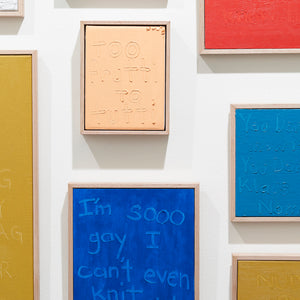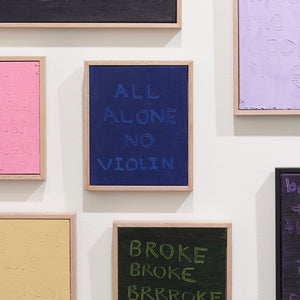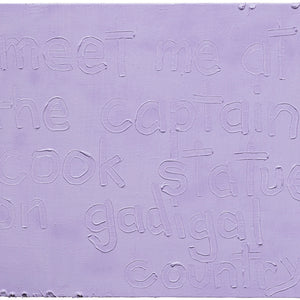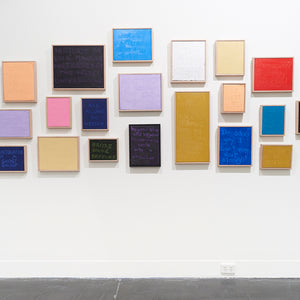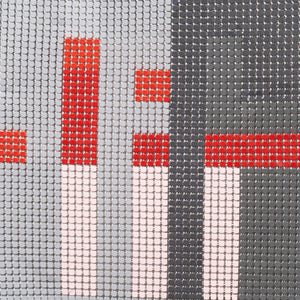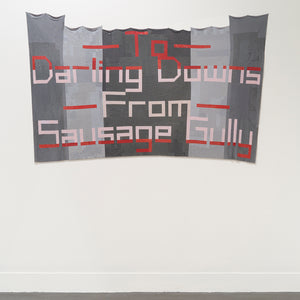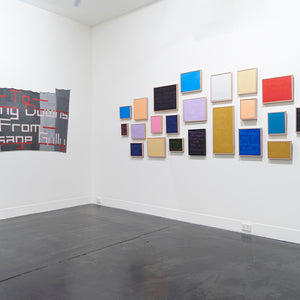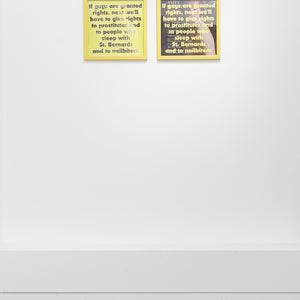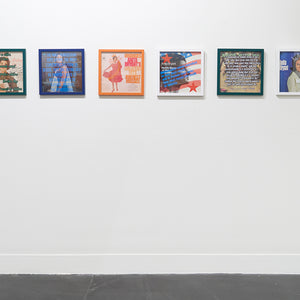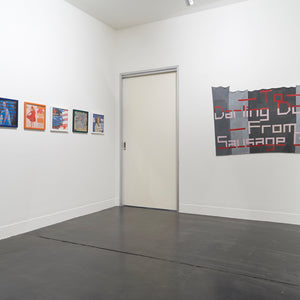Troy-Anthony Baylis YES, I AM MUSICAL
6 October to 6 November 2021
'Yes, I am Musical' by Daniel Mudie Cunningham
Yes, I Am Musical is a pronouncement in paint. It picks up its rhythm from a quaintly coded 1950s question used to identify homosexual men – ‘are you musical?’, ‘is he musical?’
In this new exhibition, Troy-Anthony Baylis bristles through play, gently and humorously prodding at language and visual culture through the resonances of popular music. Through declarative statements and sharp wordplay, Baylis mines his vast musical knowledge to carry forward queer culture and experience.
The exhibition brings together three bodies of work: a major new piece in his acclaimed Glomesh and ‘faux-mesh’ Postcard series, which reads To Darling Downs from Sausage Gully; a series dubbed Immediacy Paintings; and his Anita Bryant Monuments collages.
The Immediacy Paintings read like witty haikus punning on the vernacular of the past within the present tense – and a tense present it is. Baylis has been creating Immediacy Paintings intermittently since the late 1990s. Usually small in scale, these are works that he creates within a day. Once a single colour of oil paint is applied over the entire canvas, he writes into the surface with a small stick-like tool. The neat consistency of his handwriting becomes a cartoonish typeface in the service of sabotaging stereotypes set to implied stereophonic sound.
Each text of the Immediacy Paintings articulates seemingly mundane moments, slogans, thoughts and aspirations. Baylis sees the arrangements of words on the canvas as petroglyphic, sometimes subtle, sometimes stark. The phrases can appear as non-sequiturs, but gradually unpack their layers as cultural connections manifest, revealing multivalent readings. ‘These oily play-areas are sites for colliding cultural matter, making references to all kinds of interests, all sorts of subjects,’ he says.
One such ‘play-area’ is at the sites of contested monuments. The painting meet me at the captain cook statue on gadigal country riffs on recent calls to topple colonial monuments. Baylis proposes a site for Country and colonialism to ‘meet’, however unsettling and uncomfortable that place of reconciliation might be – especially in recent times, as contemporary cancel culture pushes to do the opposite by obliterating markers of colonial trespass and brutality as if it never happened. As such, Baylis claims to be in the ‘keep-the- James-Cook-statue camp’. He wants to be reminded of the claim of terra nullius and the atrocity that followed. ‘Sometimes I incorporate colonial subject matter into my practice, just like pests and parasites are used in permaculture ecology, to make it strong, to make beauty.’
This thinking informs his Anita Bryant Monuments. In these works, Baylis reconsiders the homophobic hate speech of the controversial evangelical Christian Anita Bryant (b. 1940). Emerging in the 1950s in various guises from beauty pageant queen to schmaltzy pop singer to brand ambassador, the now octogenarian Bryant is, sadly, best remembered for her anti-gay-rights activism and fearmongering. Baylis repurposes the cover art of Bryant’s Greatest Hits vinyl compilation album issued by Columbia Records in 1963. His 2021 appropriation uses her own hate speech as a strategy of defacement and graphic agitation. I’m reminded of a history of book burnings staged by Christians to cancel ‘the work of the devil’. Instead, Baylis reinforces her harmful homophobia at the same time as he acknowledges her place in popular culture. Playing both sides of the record, so to speak, Baylis finds room for Bryant in his little corner of the world – as the song would have it.

